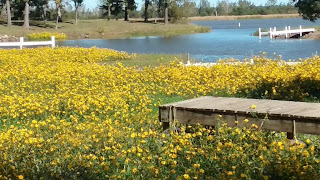Water Primrose is Ludwigia peploides glabrescens
 |
| Spaniard Creek on the Arkansas River |
It turns out that this source of insect pollen is none other than Creeping Water Primrose. The South American variety is Ludwigia hexapelata and the US native variety is Lusdwigia peploides glabrescens.
South American Water Primrose is so invasive in fact that in many states there are programs to eradicate it to prevent its clogging irrigation channels, rivers and lakes. In addition it is well known as mosquito breeding heaven. The native variety, L peploides is called aggressive rather than invasive.
 |
| Ludwigia peploides glabrescens |
"The flowers are cross-pollinated primarily by bees, including honeybees, digger bees (Eucerine), and Halictid bees. Other visitors, such as flies and skippers, are less effective at cross-pollination. These insects obtain nectar and/or pollen from the flowers. Some insects feed destructively on Creeping Water Primrose. This includes the flea beetles, Altica litigata and Lysathia ludoviciana, and a leafhopper, Draeculacephala inscripta. The Mallard and possibly other ducks feed on the seed capsules. Because of the large dense colonies that this plant often forms, it provides good cover along shorelines for various insects, frogs, and other wetland wildlife."
We saw several box and snap turtles in and among the Water Primrose at Spaniard Creek Park.
If you haven't visited Spaniard Creek Park, this is a gorgeous time of year to walk along the water's edge as the trees enter their fall stage and drop acorns. There are very few campers now so walkers have plenty of room to roam and appreciate the beauty of Oklahoma fall.




Comments